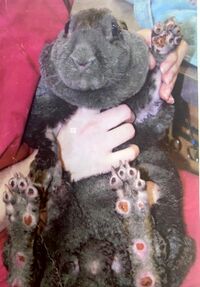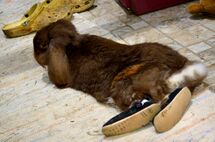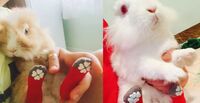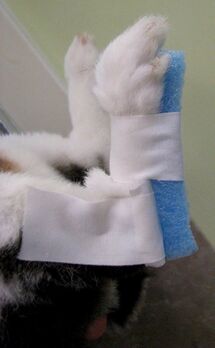Sore hocks
Sore hocks or ulcerative pododermatitis is a condition in rabbits characterized by ulcerated, infected areas of skin usually on the rear limbs but can also affect the front feet. Sore hocks is a painful condition and can be irreversible depending on severity.[1]
Causes


Rabbits normally bear weight on their hind digits during locomotion in a digitigrade stance. At rest, weight is born in the area between the hind claws and hock, or a plantigrade stance. Rabbits do not have foot pads but instead rely on a covering of thick fur (guard hairs) on the bottom of the feet, combined with a compliant surface, to protect the feet.[2]

Any condition that disrupts normal digitigrade locomotion or cushioning of the plantar aspect of the feet may lead to the formation of pressure sores on the feet.[1] Such conditions can include the following:
- Decreased weight bearing on other feet.
- Constant pressure applied to skin and soft tissues pressed between the bones of the feet and a hard surface.
- Improper flooring such as wire cages, hard surfaces, or soiled or damp bedding.[3]
- Lack of exercise in combination with small cages or housing.
- Underlying conditions such as obesity, urine scald, and spinal arthritis.
- Regular clipping or shaving of the thick, protective fur on the heels of a rabbit.
- History of fur loss on the bottom of the feet.
- Reluctance to move due to pain causing long sedentary periods.
- Pus-causing bacteria from infections such as Staphylococcus aureus and Pasteurella multocida.[3]
- Regular thumping and stamping by nervous, stressed rabbits.
- Trauma or puncture wounds to the heels.
- Some breeds, especially New Zealand White, normally lose fur on the ventral aspect of the hock with age.[1] This may be a normal finding or may predispose to sore hocks.

Sore hocks are often found in rabbits housed in wire cages or hutches as well as house rabbits housed on hard floors or carpeting.[1] Large rabbits such as Flemish Giants and angoras, rabbits with shortened guard hairs on their feet like Rexes, and obese, emaciated, or pregnant rabbits are more vulnerable to sore hocks.[2][3]
Diagnosis

- Early, asymptomatic disease (Grade I). Hair loss on the bottom of the feet or hocks.
- Mild disease (Grade II). Redness and swelling with overlying skin intact.
- Moderate disease (Grade III). Ulceration and scab formation.
- Severe disease (Grade IV). Abscess and inflammation of tendons or deeper tissues.
- Severe, often irreversible disease (Grade V). Bone infection along with joint and tendon swelling leading to abnormal stance and gait.
Treatment and prevention
Depending on the severity of the case, nursing care can include the following:
- For early stages of the disease, Grade I and II, caging on soft, dry bedding may be effective. Clean hay, shavings, shredded paper, towels, and blankets over padded surface that can be completely cleaned and dried works well.[1]
- More severe symptoms may require frequent removal of the dead tissue and flushing of the wound along with frequent bandage changes long-term antibiotics and pain control.
- In rabbits with severe wounds, activity should be restricted until adequate healing has taken place.
- In the long term, activity should be encouraged as prolonged inactivity can cause or exacerbate sore hocks.
Medication that may be prescribed include the following:
- Antibiotics. If an infection has already set in, a culture & sensitivity test is recommended for ideal antibiotic choice. Depending on severity, long-term antibiotic treatment may be necessary, on the order of 4-6 weeks minimum to several months.[1] Broad-spectrum oral antibiotics used to treat the condition include enrofloxacin (Baytril), marbofloxacin (Zeniquin), and trimethoprim-sulfa (Tribrissen, Septra, Bactrim, Cotrim, Sulfatrim).[1] If anaerobic infections are suspected, oral drug treatments include chloramphenicol (Chloromycetin, CHPC) or azithromycin (Zithromax) which can be used either alone or combined with metronidazole (Flagyl).[1] Be careful with prolonged high-dose metronidazole as it can be potentially toxic to the vestibular system.[1] For injection drugs, treatments include penicillin, penicillin G benzathine, or penicillin G procaine.[1] Remember, penicillin-type drugs should never be prescribed as an oral drug as it can cause fatal enteric dysbiosis and enterotoxemia.[1]
- Acute pain management. Drugs may include butorphanol (Stadol, Torbutrol, Torbugesic), buprenorphine (Buprenex), hydromorphone (Dilaudid-HP), meloxicam (Metacam, Mobic, Mobicox), or carprofen (Rimadyl, Novox, Vetprofen).
- Long-term pain management. NSAIDs are the drug of choice and common choices include meloxicam (Metacam, Mobic, Mobicox) or carprofen (Rimadyl, Novox, Vetprofen).
The following are some suggestions that can be used to keep sore hocks from developing:[4]
- Keep rabbits on soft, dry surfaces and not linoleum, hardwood, or cement. See Housing for more ideas. Egg-crate foam or plastic bubble wrap underneath bedding can help evenly distribute pressure on your rabbit's hock.[5]
- Check feet daily. See Wellness Check for more checks to do regularly.
- Apply cooled tea bags (compress) to hocks to toughen calluses.
- Use soft and absorbent litter such as Carefresh or Cat Country on the bottom topped with a large scoop of Carefresh (paper pulp litter).
- In an outdoor playpen, line the floor with with 6 inches of soft, clean, short-cut, yellow straw.
- Keep toenails clipped short. See Grooming for more details.
- Disinfect cages regularly.
The following are some additional resources that can help your bunny's sore hocks:
- Magic Happens Rabbit Rescue. Habitats for Specific needs
Experiences
Below are some experiences with sore hocks.
- Mini Lop Hop. (2012). Sore Hocks
- Lisa Bruce. Sore Hocks (pododermatitis) in Rabbits
Further reading
- DisabledRabbits.com. Sore Hocks
- Esther van Praag. Rabbit socks for pododermatitis or foot wounds [PDF]
- One Two Hop. Rabbit socks for sore hocks.
- PetMD. Sore Hocks in Rabbits
- Dana Krempels. Treating Sore Hocks in Your Companion Rabbit
- The Merck Veterinary Manual. Ulcerative Pododermatitis on "Noninfectious Diseases of Rabbits" page.
References
- ↑ 1.00 1.01 1.02 1.03 1.04 1.05 1.06 1.07 1.08 1.09 1.10 Oglesbee, B. (2011). Blackwell's Five-Minute Veterinary Consult: Small Mammal. (2nd ed.).
- ↑ 2.0 2.1 Quesenberry, K & Carpenter, J. (2012). Ferrets, Rabbits, and Rodents: Clinical Medicine and Surgery. (3rd ed.).
- ↑ 3.0 3.1 3.2 Mitchell, M. A., & Tully, T. N. (2016). Current therapy in exotic pet practice. Retrieved from https://books.google.com/books?id=Cqc_CwAAQBAJ
- ↑ Harriman, M. (1994). Foot Problems. Retrieved 7 March 2016 from http://rabbit.org/foot-problems/
- ↑ DisabledRabbits.com. (n.d.). Sore Hocks. Retrieved 25 Nov 2019 from http://www.disabledrabbits.com/sore-hocks.html

